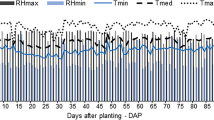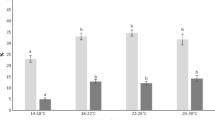Abstract
Tembotrione is a herbicide belonging to the triketone group, which is commonly used for postemergence weed control in maize fields. However, its application can have unintended effects on plants growing on neighboring land, due to factors such as spray drift, carryover, and residue in soils. These off-target effects can potentially cause harm to non-target plants and ecosystems. Off-target application of tembotrione to tomato plants can result in negative effects such as various patterns of chlorosis and reduction in growth, yield, and quality. These effects can adversely impact tomato plants and their ability to produce healthy fruit. Field trials were conducted to explain the negative effects of tembotrione on tomato plants at a rate of 20% of the recommended dose specified on the label. Several growth parameters were measured during the trial to assess the impact of tembotrione on tomato plants: fresh and dry biomass of plants (g), leaf area (cm2), yield (kg plot−1), fruit length (cm), fruit diameter (cm), titrable acidity (%), soluble solid content (%), and pH. According to the results obtained, tembotrione negatively affected tomato plants. The applied dose of tembotrione mostly had a negative effect on the quality of both the tomato foliage and fruits. However, despite this negative effect, there was no statistically significant impact on the yield. In fact, the yield slightly increased as a result of tembotrione treatment. On the other hand, use of tembotrione caused a decrease in the marketable yield of tomatoes due to a reduction in the visual quality of the fruits. Additionally, the tembotrione drift simulation treatment resulted in an increase of approximately 17.5% in titrable acidity (TA).





Similar content being viewed by others
References
Accinelli C, Vicari A, Pisa PP, Catizone P (1999) Losses of atrazine, metalochlor, prosulfuron and triasulfuron in subsurface drain water. Abstracts 11th EWRS Symposium, Basel, p 139
Anonymous (2021) The use of pesticides in developing countries and their impact on health and the right to food. Policy department for external relations, Directorate General for External Policies of the Union 653.622, https://www.europarl.europa.eu/thinktank/en/document/EXPO_STU(2021)653622
Aregay FA, Minjuan Z (2012) Impact of irrigation on fertilizer use decision of farmers in China: a case study in Weihe river basin. J Sustain Dev. https://doi.org/10.5539/jsd.v5n4p7
Barabasz W, Albińska D, Jaśkowska M, Lipiec J (2002) Biological effects of mineral nitrogen fertilization on soil microorganisms. Pol J Enviromental Stud 11:193–198
Carlsen SCK, Spliid NH, Svensmark B (2006) Drift of 10 herbicides after tractor spray application. 2.Primary drift (droplet drift). Chemoshere 64:778–786. https://doi.org/10.1016/j.chemosphere.2005.10.060
Carneiro GDOP, Bontempo FA, Guimarães FAR, Reis MR, Silva DV, Souza MF, Lins HA (2019) Carryover tembotrione and atrazine in sugar beet. Cien Investig Agrar 46(3):319–324. https://doi.org/10.7764/rcia.v46i3.2006
Chakrabarty T, Akter S, Saifullah ASM, Sheikh SMD, Bhowmick AC (2014) Use of fertilizer and pesticide for crop production in Agrarian area of Tangail district, Bangladesh. Eniriment Ecol Res 2(6):253–261. https://doi.org/10.13189/eer.2014.020605
Chu CC, Plate H, Matthews DL (1984) Fertilizer injury to patatoes as affected by fertilizer source, rate and placement. Am J Potato Res 55:117–121
Eberlein CV, Westra P, Hederlie LC, Whitmore JC, Guttieri MJ (1997) Herbicide drift and carryover injury in potatoes. Pacific Northwest Extension Publ, Idaho, p 498
FAO (2021) Food and agriculture organization of the United Nations statistics division website. http://www.fao.org/faostat/en/#data/QC/visualize. Accessed December 2022
Galhano V, Laranjo GJ, Valiente EF, Videira R, Peixoto F (2011) Impact of herbicides on non-target organisms in sustainable irrigated rice production systems: state of knowledge and future prospects, p 45 (chapter 2)
Gungor Y, Erozel AZ, Yıldırım O (1996) Irrigation. Publication No: 1443, Lecture 259 Book: 424. Ankara University, Faculty of Agriculture, Ankara
Henareh M, Dursun A, Mandoulakani BA (2015) Genetic diversity in tomato landraces collected from Turkey and Iran revealed by morphological characters. Acta Sci Pol Hortorum Cultus 14(2):87–96
Howell T (2001) Enhancing water use efficiency in irrigated agriculture. Argon J 93:281–289. https://doi.org/10.2134/agronj2001.932281x
Lovelace LM, Talbert RE, Scherder EF, Hoagland RE (2007) Effects of multiple applications of smilated quinclorac drift rates on tomato. Weed Sci 55(2):169–177. https://doi.org/10.1614/WS-06-054
Nordby A, Skuterud R (1974) The effects of bloom height, working pressure and wind speed on spray drift. Weed Res 14:385–395
Olofsdotter M, Watson A, Piggin C (1998) Weeds a looming problem in modern rice production. In: sustainability of rice in the global food system. In: Dowling NG, Greanfield SM, Fisher KS (eds) Pasific basin study center, international rice research institute. Davis, pp 165–173. ISBN 971-22-0107‑4
Pham DM, Hwang H, Park SW, Cui M, Lee H, Chun C (2019) Leaf chlorosis, epinasty, carbohydrate contents and growth of tomato show different responses to the red/blue wavelength ratio under continuous light. Plant Physiol Biochem 141:477–486. https://doi.org/10.1016/j.plaphy.2019.06.004
Rosemmand A (2000) Herbicide movement in soils: principles, pathways and processes. Weed Res 40:113–122. https://doi.org/10.1046/j.1365-3180.2000.00157.x
Thornton (2001) Chemical injury. In: Stevenson WR, Loria R, Franc GD, Weingartner DP (eds) Compendium of potato diseases. American Phytopathological Society, Saint Paul, pp 92–94
Acknowledgements
We would like to thank Prof. Dr. Hamit Altay for his assistance in the translation of the abstract into German.
Author information
Authors and Affiliations
Corresponding author
Ethics declarations
Conflict of interest
M. Yıldırım, S. Kaya and U. Mucan declare that they have no competing interests.
Rights and permissions
Springer Nature oder sein Lizenzgeber (z.B. eine Gesellschaft oder ein*e andere*r Vertragspartner*in) hält die ausschließlichen Nutzungsrechte an diesem Artikel kraft eines Verlagsvertrags mit dem/den Autor*in(nen) oder anderen Rechteinhaber*in(nen); die Selbstarchivierung der akzeptierten Manuskriptversion dieses Artikels durch Autor*in(nen) unterliegt ausschließlich den Bedingungen dieses Verlagsvertrags und dem geltenden Recht.
About this article
Cite this article
Yıldırım, M., Kaya, S. & Mucan, U. Influence of Simulated Tembotrione Drift on Growth and Yield of Drip-Irrigated Tomato. Gesunde Pflanzen 75, 2319–2325 (2023). https://doi.org/10.1007/s10343-023-00891-8
Received:
Accepted:
Published:
Issue Date:
DOI: https://doi.org/10.1007/s10343-023-00891-8




